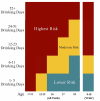A Screening Tool for Assessing Alcohol Use Risk among Medically Vulnerable Youth
- PMID: 27227975
- PMCID: PMC4882018
- DOI: 10.1371/journal.pone.0156240
A Screening Tool for Assessing Alcohol Use Risk among Medically Vulnerable Youth
Abstract
Background: In an effort to reduce barriers to screening for alcohol use in pediatric primary care, the National Institute on Alcoholism and Alcohol Abuse (NIAAA) developed a two-question Youth Alcohol Screening Tool derived from population-based survey data. It is unknown whether this screening tool, designed for use with general populations, accurately identifies risk among youth with chronic medical conditions (YCMC). This growing population, which comprises nearly one in four youth in the US, faces a unique constellation of drinking-related risks.
Method: To validate the NIAAA Youth Alcohol Screening Tool in a population of YCMC, we performed a cross-sectional validation study with a sample of 388 youth ages 9-18 years presenting for routine subspecialty care at a large children's hospital for type 1 diabetes, persistent asthma, cystic fibrosis, inflammatory bowel disease, or juvenile idiopathic arthritis. Participants self-administered the NIAAA Youth Alcohol Screening Tool and the Diagnostic Interview Schedule for Children as a criterion standard measure of alcohol use disorders (AUD). Receiver operating curve analysis was used to determine cut points for identifying youth at moderate and highest risk for an AUD.
Results: Nearly one third of participants (n = 118; 30.4%) reported alcohol use in the past year; 86.4% (106) of past year drinkers did not endorse any AUD criteria, 6.8% (n = 8) of drinkers endorsed a single criterion, and 6.8% of drinkers met criteria for an AUD. Using the NIAAA tool, optimal cut points found to identify youth at moderate and highest risk for an AUD were ≥ 6 and ≥12 drinking days in the past year, respectively.
Conclusions: The NIAAA Youth Alcohol Screening Tool is highly efficient for detecting alcohol use and discriminating disordered use among YCMC. This brief screen appears feasible for use in specialty care to ascertain alcohol-related risk that may impact adversely on health status and disease management.
Conflict of interest statement
Figures
Similar articles
-
Reliability and Validity of a Two-Question Alcohol Screen in the Pediatric Emergency Department.Pediatrics. 2016 Dec;138(6):e20160691. doi: 10.1542/peds.2016-0691. Pediatrics. 2016. PMID: 27940674 Free PMC article.
-
Identifying adolescents with alcohol use disorder: Optimal screening using the National Institute on Alcohol Abuse and Alcoholism screening guide.Psychol Addict Behav. 2018 Aug;32(5):508-516. doi: 10.1037/adb0000377. Epub 2018 Jul 5. Psychol Addict Behav. 2018. PMID: 29975071 Free PMC article.
-
AUDIT-C scores as a scaled marker of mean daily drinking, alcohol use disorder severity, and probability of alcohol dependence in a U.S. general population sample of drinkers.Alcohol Clin Exp Res. 2013 Aug;37(8):1380-90. doi: 10.1111/acer.12092. Epub 2013 Apr 23. Alcohol Clin Exp Res. 2013. PMID: 23906469
-
Primary care management of alcohol use disorder and at-risk drinking: Part 1: screening and assessment.Can Fam Physician. 2015 Jun;61(6):509-14. Can Fam Physician. 2015. PMID: 26071154 Free PMC article. Review.
-
Screening and brief intervention for alcohol and other abuse.Adolesc Med State Art Rev. 2014 Apr;25(1):126-56. Adolesc Med State Art Rev. 2014. PMID: 25022191 Review.
Cited by
-
Predictive Validity of a 2-Question Alcohol Screen at 1-, 2-, and 3-Year Follow-up.Pediatrics. 2019 Mar;143(3):e20182001. doi: 10.1542/peds.2018-2001. Epub 2019 Feb 19. Pediatrics. 2019. PMID: 30783022 Free PMC article.
-
Screening for Adolescent Alcohol Use in the Emergency Department: What Does It Tell Us About Cannabis, Tobacco, and Other Drug Use?Subst Use Misuse. 2019;54(6):1007-1016. doi: 10.1080/10826084.2018.1558251. Epub 2019 Feb 6. Subst Use Misuse. 2019. PMID: 30727811 Free PMC article.
-
Psychoeducational Messaging to Reduce Alcohol Use for College Students With Type 1 Diabetes: Internet-Delivered Pilot Trial.J Med Internet Res. 2021 Sep 30;23(9):e26418. doi: 10.2196/26418. J Med Internet Res. 2021. PMID: 34591022 Free PMC article. Clinical Trial.
-
Association of Screening and Brief Intervention With Substance Use in Massachusetts Middle and High Schools.JAMA Netw Open. 2022 Aug 1;5(8):e2226886. doi: 10.1001/jamanetworkopen.2022.26886. JAMA Netw Open. 2022. PMID: 35972741 Free PMC article.
-
Screening and Counseling for Alcohol Use in Adolescents With Chronic Medical Conditions in the Ambulatory Setting.J Adolesc Health. 2019 Jun;64(6):804-806. doi: 10.1016/j.jadohealth.2019.02.011. J Adolesc Health. 2019. PMID: 31122509 Free PMC article.
References
-
- Young A, Grey M, Abbey A, Boyd CJ, McCabe SE. Alcohol-related sexual assault victimization among adolescents: prevalence, characteristics, and correlates. J Stud Alcohol Drugs. 2008;69(1):39–48. Available: http://www.pubmedcentral.nih.gov/articlerender.fcgi?artid=2713994&tool=p.... Accessed 2015 Nov 3. - PMC - PubMed
-
- Crosnoe R. The Connection Between Academic Failure and Adolescent Drinking in Secondary School. Sociol Educ. 2006;79(1):44–60. Available: http://www.pubmedcentral.nih.gov/articlerender.fcgi?artid=2834180&tool=p.... Accessed 2015 Oct 29. - PMC - PubMed
MeSH terms
Grants and funding
LinkOut - more resources
Full Text Sources
Other Literature Sources
Medical
Miscellaneous


